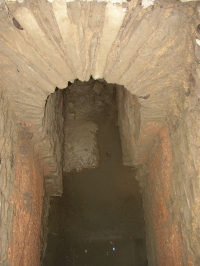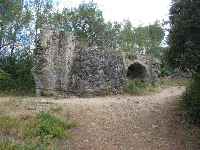


Maintenance
Roman aqueducts required a comprehensive system of maintenance and repair of accidental leaks and breaches, to clear lines of debris and to remove the built up of calcareous deposits called sinter, that naturally occur in the water. Agrippa rearranged the maintenance of the aqueducts of Rome and caesar Claudius added extra personnel to that, see Administration, based on Frontinus 116.After construction maintenance paths or roads were built along the trace. These also served to delimit the areas where farming and other activities were not permitted, sometimes bordered by marking stones, the so-called 'cippi' (singular cippus) earmarking an an area of 15 meters on both sides of the aqueduct trace. Also local announcements are known like the inscription - the Pierre de Chagnon - near the Gier aqueduct of Lyon, stating that
By authority of caesar Traianus Hadrianus Augustus nobody has the right to work, sow or plant in this area which is earmarked for the protection of the aqueduct.
Many aqueducts were equipped at more or less constant distances with manholes (putei, singular puteus) facilitating access to the subterranean channels. Vitruvius (8,4,3) wrote about 35,5 meters ( = 1 actus = 120 Roman feet), Plinius (NH 31,31) advised 71 meters ( = 2 actus). The distance between the manholes in the Gier aqueduct of Lyon is estimated between 72 and 77 meters. Although, some manholes were also present on top of arcaded channeld like the access shafts on top of the Plat d'Air arcade in Chapognost (Gier aqueduct of Lyon). Additional manholes were built where intensive maintenance or frequent repairs were necessary.
Frontinus gives a detailed description of the maintenance crews under responsibility of the curator aquarum of Rome, their duties and the "dishonest practice of the watermen", see Frontinus 144 onwards.
Maintenance was not always successful. Both Juvenal and Martial refer to the Porta Capena in Rome as a wet gateway or dripping arch, although it is unclear which aqueduct was involved.
With the fall of the Roman empire many aqueducts fell into disuse from lack of maintenance, although some were still active in the Middle Ages and even beyond, see Later history.